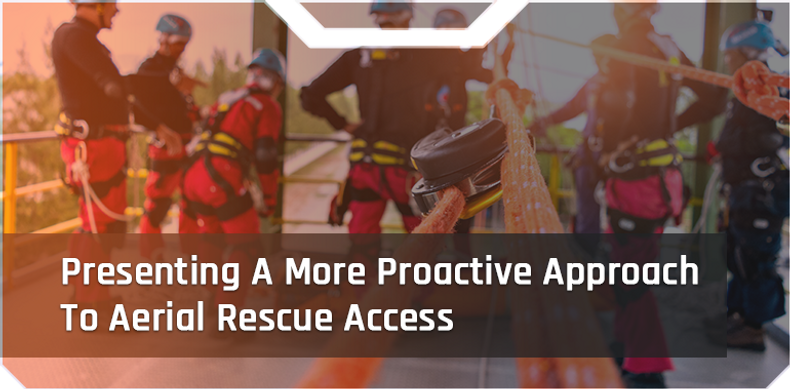According to some reports, Arborist fatalities occur on job sites almost weekly. This is in part due to the risky nature of Tree Work, but it should also be said that there are other lines of work that pose similar dangers where fatality rates are significantly lower.
In recent years, there has been a lot of discussion about how to make Tree Work safer.
One strategy that Arborists are starting to adopt from other industries more frequently is the concept of pre-installing a secondary access line for aerial rescue every time that there is a climber in a tree.
This requires more gear and some people may argue that it unnecessarily slows down setup, but there are some very strong arguments for why these types of precautions are worth it.
Why Would You Set Up A Secondary Access Line?
Why would you want to make more work for yourself and your crew? Most of us want to get a job started as quickly as possible and then end early whenever possible.
When it comes to Aerial Rescue, one thing that is super important to remember is that most Emergency Workers are not trained to climb trees. This means that in the case of an accident, ultimately someone in an Arborist Work Crew will likely be retrieving the victim anyway.
In situations where every second counts, it may be desirable to start a rescue before emergency workers are able to arrive.
Some Reasons To Installing A Secondary Access Line For Every Climb:
- The Line That The Victim Is On May Be Damaged
- Most Emergency Workers Are Not Trained To Climb Trees
- During Rescues, Every Second Saved Can Decrease Injuries
- It Will Take Some Time Before Any Emergency Workers Will Arrive
- Secondary Lines Are The Most Accepted Way To Retrieve A Victim
- In Many Cases, An Arborist Will Be Retrieving A Victim From A Tree
By setting up a secondary line before an incident occurs drastically cuts down the time it takes to access a victim.
If you wait until an accident happens, you may be attempting to climb up the same line that the victim was using, or climbing up on spurs. Either of these methods will significantly compromise safety and efficiency.
Otherwise, you will be taking the extra time to rig a secondary line while the victim may be in increasing danger. Using a secondary access line only requires a second climber to attach to the line to start the retrieval.
Additional Proactive Strategies For Aerial Rescue
Aside from setting up a secondary access line, you should always have a rescue kit prepared. This is already a standard practice in Arboriculture.
To add extra efficiency, a harness should be set up with several things attached - extra web slings, carabiners, and a sharp knife.
Gear To Include In A Rescue Kit:
- Lanyards
- Throw Line
- Pole Pruner
- Foot Ascenders
- Knee Ascenders
- First Aid Supplies
- A Harness With Carabiners, Web Slings, And A Sharp Knife Attached
Some Things To Remember When An Aerial Rescue Is Needed
Arborists will need to complete Aerial Rescue Training, but it never hurts to give some reminders on basic practices.
Tips For Aerial Rescue:
- Call 911 ASAP
- Check Pulse And Breathing Frequently
- Be Mindful Of Energized Limbs & Other Electrical Hazards
- Continuously Communicate All Steps Out Loud To The Crew
- If There Are Electrical Hazards Present, Immediately Call Utilities
- Continuously Attempt To Establish Verbal Communication With The Victim
- If A Victim May Have A Neck Or Spinal Injury, Move Them As Little As Possible
- When Speaking To A 911 Operator, Be Sure To Inform Them Of Any Electrical Hazards Or Needs For A High Angle Rescue, So They Will Prepare The Right Rescue Equipment
What Type Of Rope Should Be Used As A Secondary Rescue Line?
Given that you are reading a blog from a rope company, you probably saw this coming. It’s time to talk ropes.
You will want any secondary rope that you install to be a rope designed specifically for Tree Work. These days, most Arborists prefer an 11 MM (7/16”) rope for access lines. A 24 strand count will make climbing quick in those applications where time is so important.
Features To Look For In An Arborist Rescue Line:
- 11 MM Diameter
- Lightweight Design
- 24 Strand Construction
- A Rope Designed For Tree Climbing
Final Thoughts
As an Arborist, you are your brother’s (and in some cases sister’s) keeper.
When you are doing Tree Work, you are in danger every day - hazards of electrocution, animal and insect attacks, swinging and falling limbs, and injuries from chainsaws.
Remember that the safety of you and your crew is priceless and worth the extra time that it takes. In the case of an emergency, make sure to call 911 as quickly as possible and provide as much useful information as possible, but also be aware that it may be necessary for someone on your crew to retrieve the climber.
Stay safe, stay healthy, and live to climb another day.





